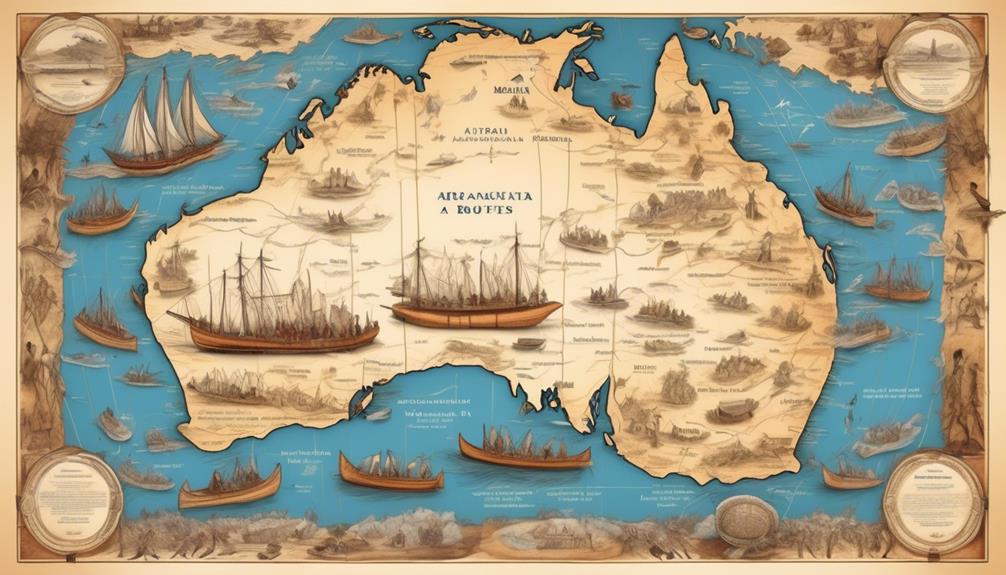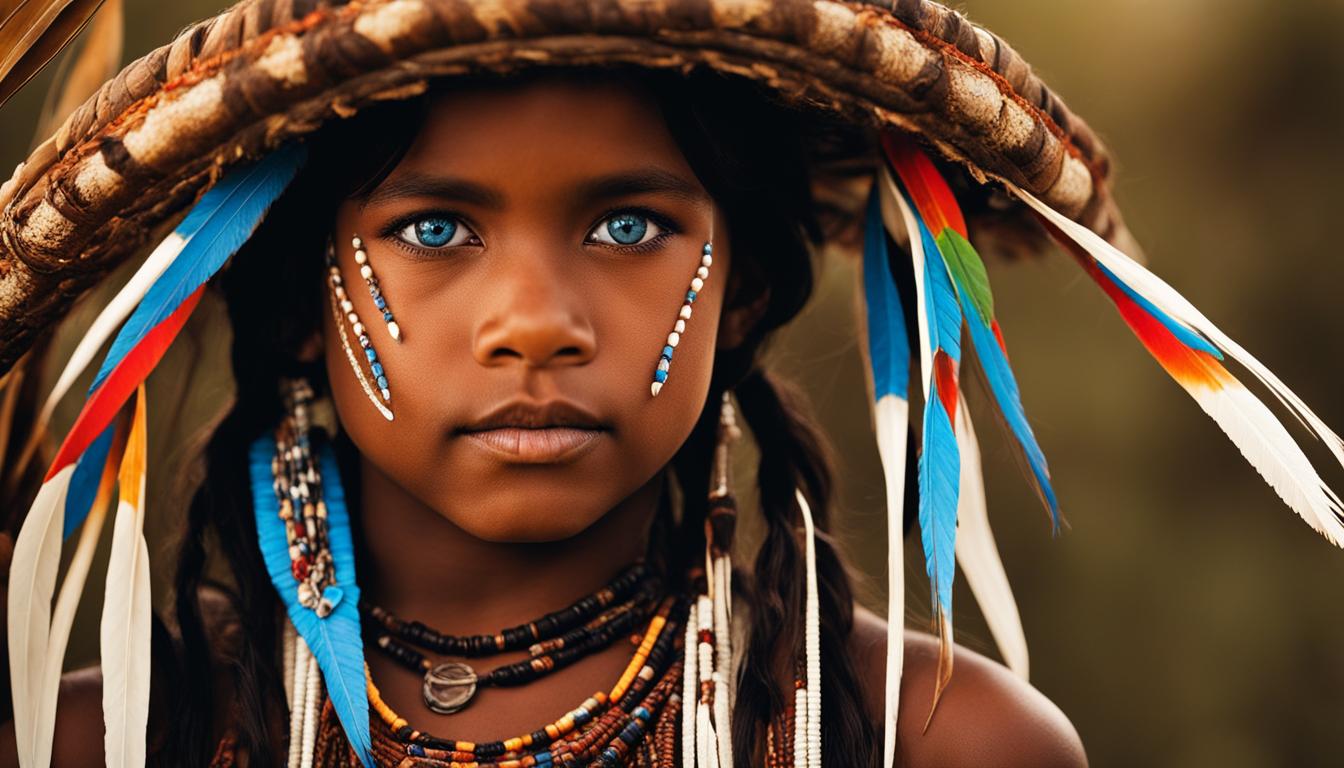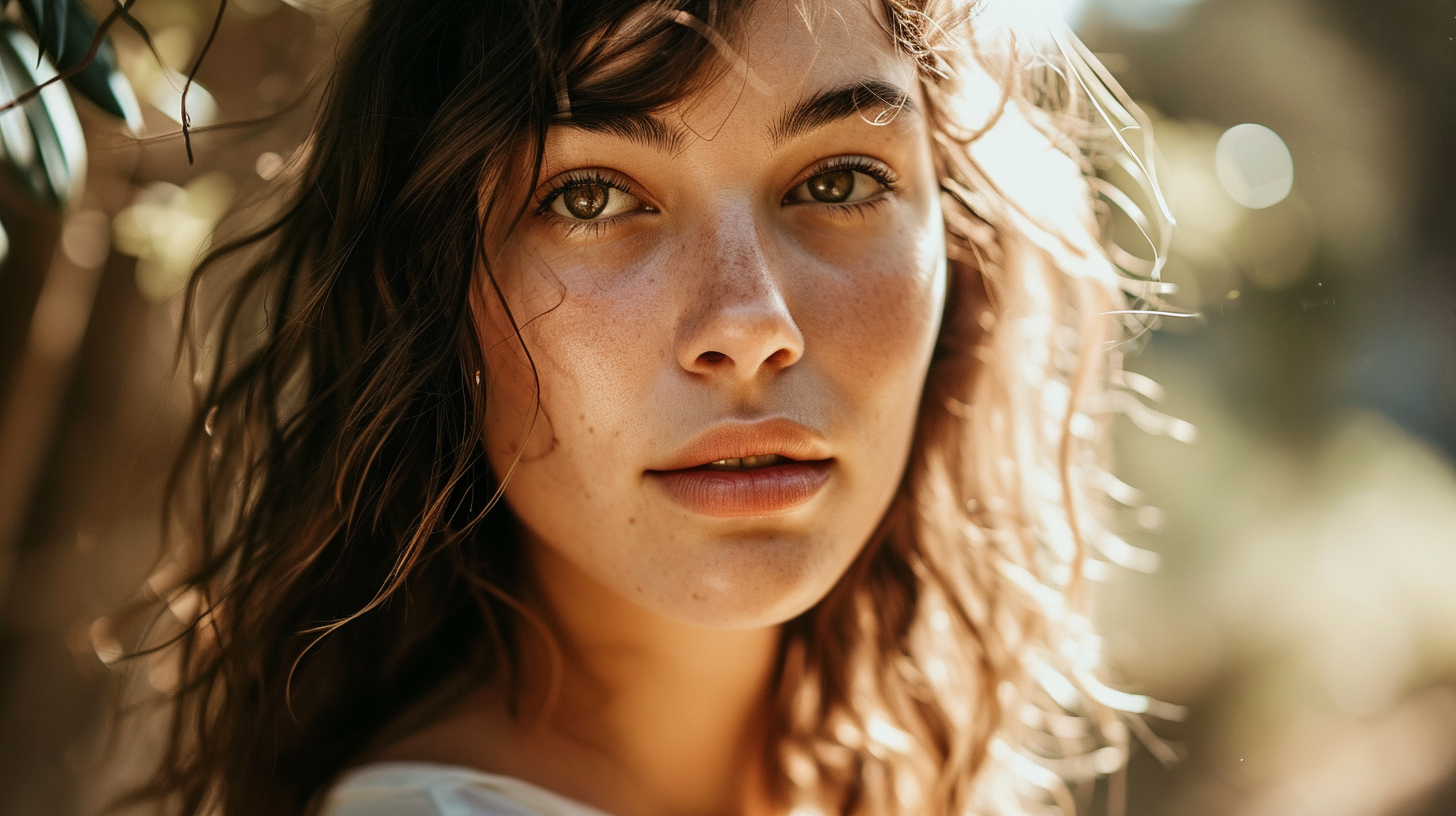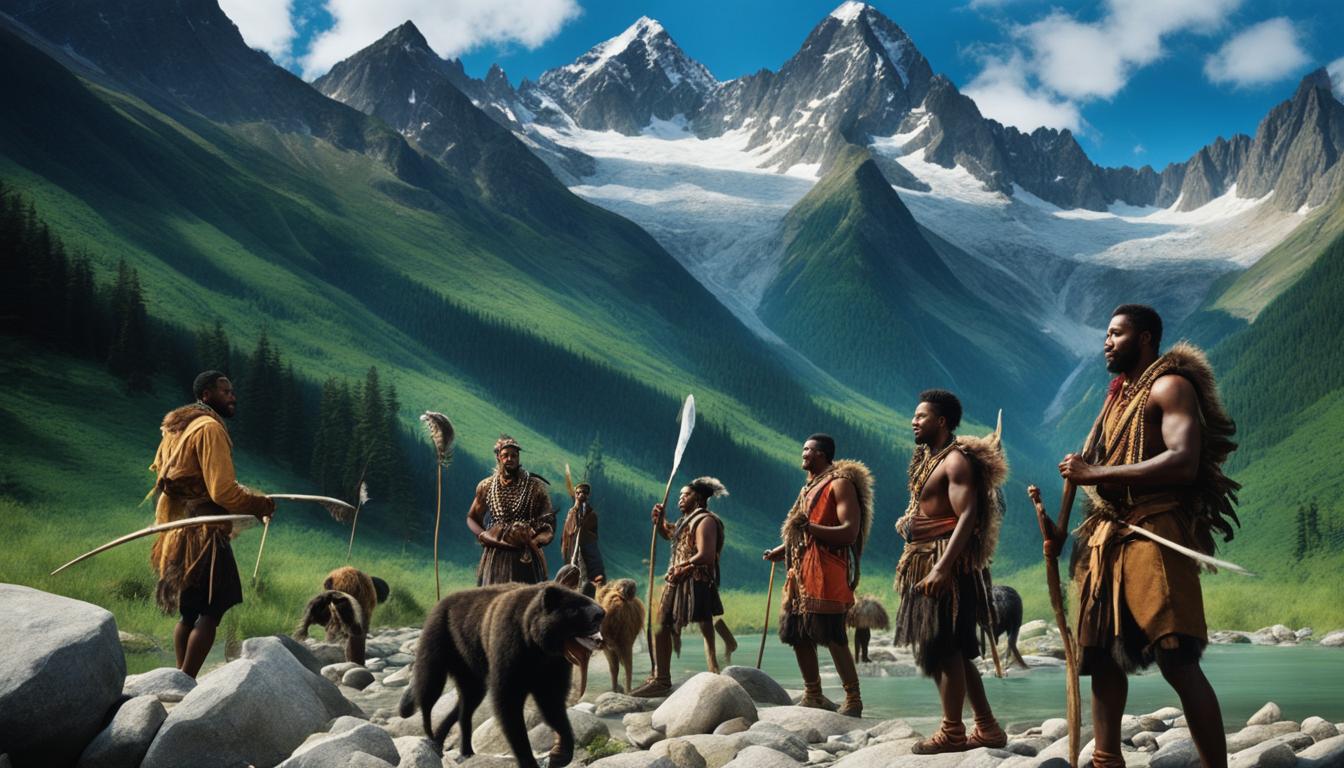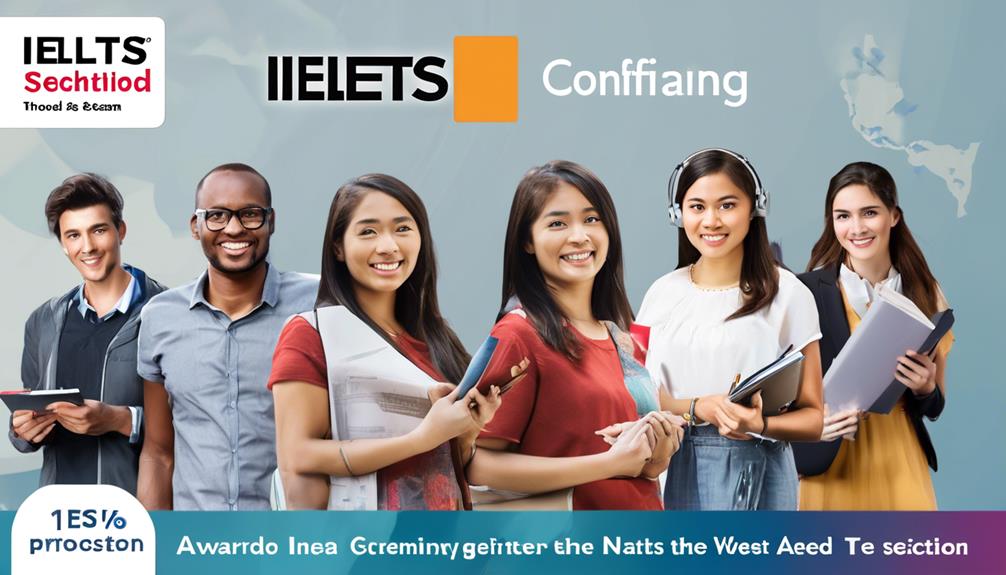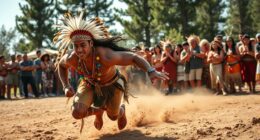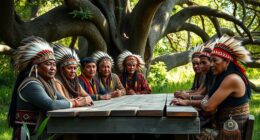A lot of us are knowledgeable about Australia’s Aboriginal population, however, what is not commonly understood is the fascinating mystery linked to their migration to the continent.
The journey of how the Aboriginal people came to inhabit Australia is a subject that has intrigued researchers and scientists for decades. It's a story that involves ancient land bridges, genetic evidence, and cultural connections with Southeast Asia.
The pieces of this puzzle have sparked heated debates and led to groundbreaking archaeological discoveries.
As we delve into the various theories and evidence, we begin to unravel the complex and captivating narrative of the Aboriginal's arrival and settlement in Australia.
Key Takeaways
- Theories suggest that the first humans arrived in Australia around 65,000 years ago, possibly using maritime routes from Southeast Asia or land bridges.
- Genetic evidence reveals the ancestral origins and migratory pathways of Aboriginal populations, showing interactions with other indigenous groups.
- Coastal migration played a significant role in the arrival of Aboriginal people in Australia, with the development of boat technology and reliance on marine resources.
- Aboriginal people developed sustainable harvesting practices, intricate systems for resource exploitation, and specialized tools and watercraft for navigation, leading to the establishment of interconnected communities and trade networks.
Early Human Migration Theories
Early human migration theories have been essential in understanding the movement of early populations across the globe, shedding light on the cultural and historical development of various regions, including Australia. The study of ancient migration patterns and human dispersal has provided significant insights into the ways in which early populations navigated and settled in different parts of the world.
In the context of Australia, these theories have been particularly instrumental in unraveling the complex story of how the continent was first inhabited by its indigenous peoples. Theories of ancient human migration to Australia have long been a subject of scholarly interest and debate. One prominent theory, supported by archaeological and genetic evidence, suggests that the first humans arrived on the continent around 65,000 years ago, possibly by navigating maritime routes from Southeast Asia. This theory aligns with the prevailing understanding of early human migration patterns, which emphasizes the remarkable seafaring capabilities of ancient populations and their ability to traverse vast bodies of water in search of new territories.
Understanding the nuances of ancient human migration to Australia is crucial for comprehending the rich tapestry of Aboriginal culture and history. It provides a foundation for appreciating the resilience and adaptability of the continent's earliest inhabitants, as well as the diverse cultural landscapes that emerged as a result of their ancient journeys. Furthermore, by delving into the intricacies of early human migration, we gain a deeper understanding of the interconnectedness of global human history and the remarkable achievements of our ancestors in populating and shaping the world as we know it.
Land Bridge Hypothesis

The Land Bridge Hypothesis posits that the earliest human migration to Australia may have occurred through the use of land bridges or now-submerged landmasses, connecting the continent to neighboring regions during periods of lower sea levels. This theory suggests that ancient populations could have migrated from Southeast Asia to Australia using these land bridges, which were exposed during the last glacial maximum around 65,000 years ago. The land bridge theory is supported by geological and archaeological evidence, including the discovery of ancient stone tools in Australia that are similar to those found in Southeast Asia.
When considering migration routes, the land bridge hypothesis offers a compelling explanation for how early humans may have reached Australia. It highlights the significance of environmental factors, such as fluctuating sea levels and landmass connections, in shaping human migration patterns. This theory also underscores the resilience and adaptability of ancient populations, who navigated challenging landscapes and utilized natural land formations to expand their territories.
Understanding the land bridge hypothesis provides valuable insights into the cultural and historical connections between different regions. It encourages us to explore the ways in which early human communities interacted with their environments and adapted to changing geographical conditions. By examining the land bridge theory within the broader context of human migration, we gain a deeper appreciation for the complex and dynamic nature of our ancestors' journeys across the globe.
Genetic Evidence
Based on genetic evidence, researchers have identified distinct markers and genealogical patterns that provide insight into the ancestral origins and migratory pathways of Aboriginal populations in Australia. Genetic studies have played a crucial role in unraveling the complex history of Aboriginal ancestry and population movements. Here are some key findings that have emerged from DNA evidence:
- Genetic Diversity: Analysis of mitochondrial DNA and Y-chromosome markers has revealed a rich tapestry of genetic diversity among Aboriginal populations, reflecting their deep ancestral roots and complex migratory history.
- Ancestral Origins: Through the examination of ancient DNA samples and modern populations, scientists have been able to trace the origins of Aboriginal peoples to specific regions and identify connections to other indigenous groups across the globe.
- Population Movements: By studying patterns of genetic variation and conducting comparative analyses with other global populations, researchers have been able to reconstruct the migratory pathways and dispersal patterns of Aboriginal ancestors throughout Australia and neighboring regions.
- Admixture and Interactions: Genetic evidence has shed light on the interactions and genetic exchanges between Aboriginal populations and external groups, providing insights into historical encounters and cultural exchanges.
- Genetic Continuity: Through the analysis of genomic data, researchers have documented the continuity of Aboriginal genetic lineages over thousands of years, highlighting the resilience and enduring presence of these ancient populations.
Genetic studies have thus become indispensable tools for understanding the rich tapestry of Aboriginal ancestry and the intricate dynamics of population movements across Australia and the broader Australasian region.
Coastal Migration

Our understanding of how Aboriginals came to Australia is enriched by exploring the subtopic of Coastal Migration.
Early watercraft use, marine resource exploitation, and coastal landscape adaptation are pivotal points in this historical trajectory.
These aspects shed light on the adaptive strategies and cultural significance of coastal migration for the Aboriginal people.
Early Watercraft Use
Arriving by sea, early Aboriginal people utilized watercraft to navigate the coastal waters of Australia, contributing to a significant coastal migration and the establishment of diverse cultural communities. The use of watercraft played a pivotal role in the migration patterns of the early settlers, shaping the cultural landscape of the continent.
- Boat technology: Early Aboriginal people developed sophisticated boat-building techniques, constructing seaworthy vessels capable of traversing long distances.
- Ocean navigation: The mastery of celestial navigation and reading ocean currents enabled the early settlers to undertake extensive sea journeys, connecting distant coastal regions.
- Migration routes: Evidence suggests that coastal migration routes were established, facilitating the movement of people, trade, and cultural exchange.
- Cultural diversity: The use of watercraft allowed for the establishment of diverse cultural communities along the Australian coastline, each with its unique traditions and practices.
- Environmental adaptation: Watercraft enabled the early Aboriginal people to adapt to various coastal environments, leading to the development of specialized maritime skills and knowledge.
Marine Resource Exploitation
Utilizing the abundant marine resources, the early Aboriginal people engaged in coastal migration, establishing interconnected communities and fostering a rich maritime culture along the Australian coastline.
Their marine resource dependence had a significant ecological impact, as it led to sustainable harvesting practices and a deep understanding of marine ecosystems.
This reliance on marine resources not only shaped their dietary patterns but also influenced their social structure, trade networks, and cultural traditions.
The Aboriginal people's profound knowledge of tides, currents, and seasonal marine life cycles enabled them to thrive in harmony with the coastal environment for thousands of years.
This intricate relationship with the marine world is evident in their art, stories, and spiritual beliefs, reflecting the profound impact of marine resource exploitation on the development of Aboriginal culture and society.
Coastal Landscape Adaptation
The Aboriginal people's deep understanding of marine ecosystems and sustainable harvesting practices not only shaped their cultural traditions but also influenced their adaptation to the coastal landscape, fostering interconnected communities and a rich maritime culture along the Australian coastline.
Coastal adaptation involved the development of intricate systems for fishing, shellfish collecting, and seaweed gathering.
Indigenous history reveals the utilization of specialized tools and watercraft for effective navigation and exploitation of coastal resources.
The Aboriginal people's profound knowledge of tides, currents, and seasonal changes facilitated their sustainable management of coastal environments.
This adaptation led to the establishment of semi-permanent settlements and trade networks, emphasizing the significance of coastal regions in Aboriginal societies.
The integration of spiritual beliefs and customs with coastal practices highlights the profound cultural significance of marine landscapes in Aboriginal life.
Island Hopping
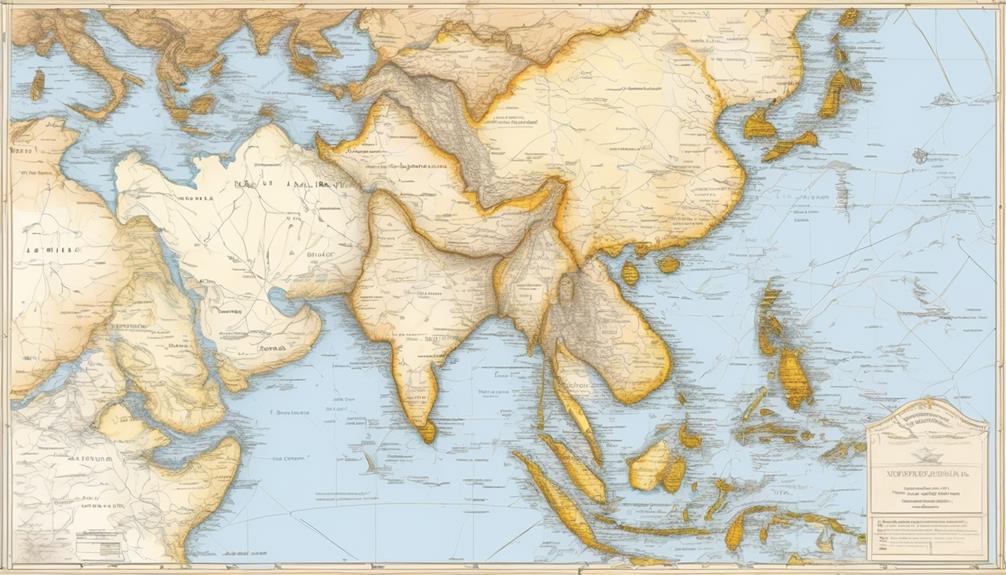
Several theories suggest that early Aboriginal people reached Australia through a series of island hops across Southeast Asia. Indigenous navigation and island exploration played crucial roles in this migratory process. The island hopping theory proposes that ancient seafaring people used boats to navigate through the Indonesian archipelago, eventually reaching the northern coast of Australia. This hypothesis is supported by archaeological evidence of early human presence on various islands along the likely maritime route.
The process of island hopping required sophisticated navigation skills and an intimate understanding of the sea. Ancient seafarers likely utilized a combination of celestial navigation, knowledge of prevailing wind patterns, and the behavior of ocean currents to traverse the waters between islands. This demonstrates the advanced maritime capabilities of the early Aboriginal people, challenging previous perceptions of their technological and navigational proficiency.
Island exploration wasn't only a means of reaching new lands but also a testament to the cultural and adaptive resilience of the ancient Aboriginals. The successful navigation of vast stretches of open water reflects their deep connection to the maritime environment and their ability to adapt to new challenges and environments.
The island hopping theory sheds light on the resourcefulness and seafaring dexterity of the early Aboriginal people. It underscores the significance of Indigenous navigation and the exploration of interconnected waterways in shaping the ancient human migration to Australia.
Cultural Connections With Southeast Asia
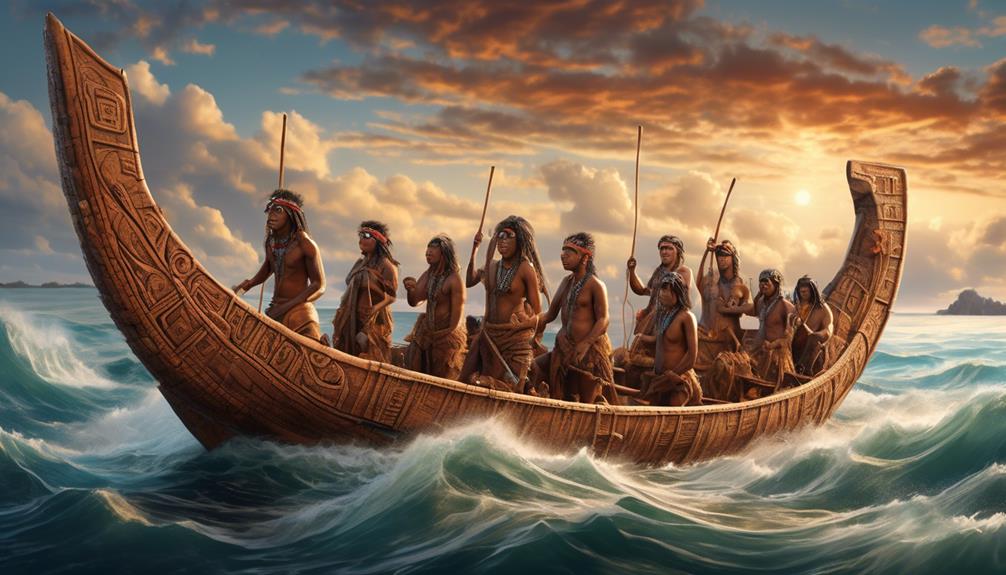
Our research reveals intriguing Southeast Asian influences on Aboriginal culture, shedding light on the extensive trade and exchange that occurred across the region.
Shared artifacts and symbols further underscore the cultural connections between Aboriginal communities and Southeast Asia, offering valuable insights into the historical interactions that shaped their identities.
This cultural exchange provides a rich tapestry of traditions and practices that continues to influence Aboriginal communities in Australia today.
Southeast Asian Influences
How did cultural connections with Southeast Asia influence the Aboriginal people of Australia? The cultural exchange and migration patterns between Southeast Asia and Australia have significantly influenced the Aboriginal people. Here are five key influences:
- Artistic Traditions: Southeast Asian artistic traditions, such as rock art and bark paintings, have influenced the artistic expressions of the Aboriginal people.
- Technological Advancements: The introduction of new technologies, such as the use of ceramics and metal tools, from Southeast Asia impacted the material culture of the Aboriginal communities.
- Language and Belief Systems: Southeast Asian languages and belief systems have contributed to the diversity of languages and spiritual beliefs among the Aboriginal groups.
- Cuisine and Agriculture: The exchange of food crops and agricultural practices with Southeast Asia influenced the development of Aboriginal culinary traditions and horticultural methods.
- Social Organization: Southeast Asian social structures and kinship systems have influenced the social organization and kinship patterns within Aboriginal societies.
Trade and Exchange
The cultural connections with Southeast Asia not only influenced the Aboriginal people's artistic traditions, technological advancements, language, belief systems, cuisine, and social organization, but also played a pivotal role in shaping trade and exchange practices in the region.
Cultural interactions with neighboring Southeast Asian societies facilitated the development of extensive trade networks. These connections enabled the exchange of goods, ideas, and technologies, contributing to the diversification of material culture and economic systems among the Aboriginal communities.
Through these trade networks, valuable resources such as tools, ochre, shells, and food items were exchanged, fostering intercultural relationships and the dissemination of knowledge. The trade and exchange practices not only sustained the economic livelihood of the Aboriginal people but also fostered an environment of cultural exchange, enriching the social fabric of the region.
Shared Artifacts and Symbols
Cultural connections with Southeast Asia have led to the sharing of artifacts and symbols, reflecting the intertwining of artistic traditions and material culture between Aboriginal communities and neighboring societies.
The symbolic representation of shared artifacts and symbols highlights the depth of cultural transmission between these communities. This exchange has resulted in the incorporation and adaptation of various artistic motifs and material objects.
Some key examples include:
- Ceremonial objects and motifs
- Rock art and cave paintings
- Tool designs and manufacturing techniques
- Spiritual and religious symbols
- Patterns and designs in textiles and crafts
These shared artifacts and symbols not only signify the interconnectedness of Aboriginal and Southeast Asian cultures but also provide a rich tapestry of cultural exchange and evolution.
Archaeological Discoveries
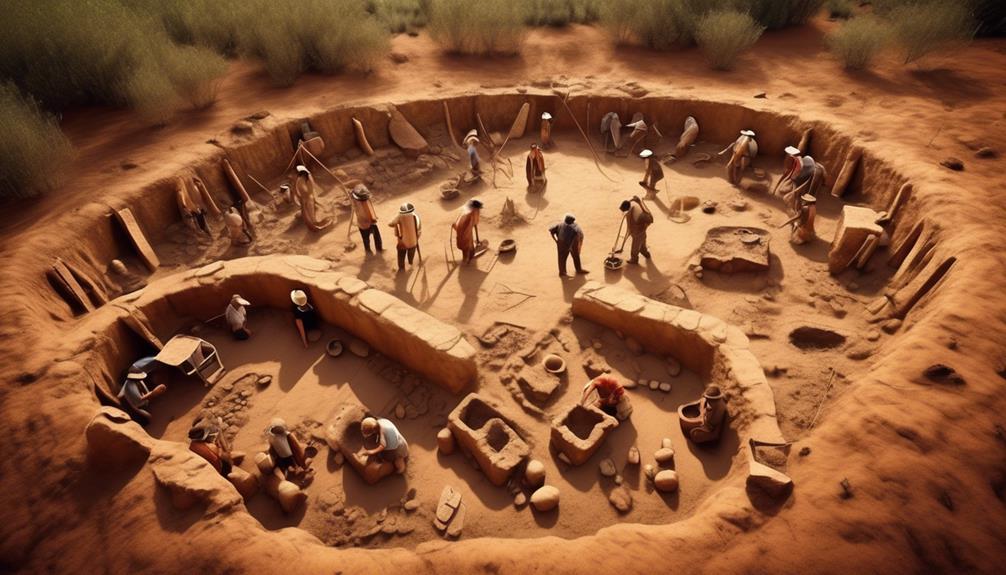
After conducting extensive archaeological excavations, researchers have uncovered evidence of the earliest Aboriginal presence in Australia dating back over 65,000 years. These discoveries provide valuable insights into the rich and diverse Aboriginal culture and the ancient artifacts that have shaped their history. The archaeological findings not only shed light on the material culture of the Aboriginal people but also offer a glimpse into their social, spiritual, and economic practices.
Excavations at sites such as Madjedbebe in the Northern Territory have unearthed stone tools, ochre crayons, and other artifacts that provide evidence of early human occupation. These discoveries challenge previous assumptions about the timing of the Aboriginal arrival in Australia and contribute to a deeper understanding of their cultural development over tens of thousands of years.
Furthermore, the careful analysis of ancient artifacts has revealed intricate details about Aboriginal subsistence strategies, trade networks, and artistic expressions. The presence of shellfish remains, for example, suggests early maritime activities, while the intricate rock art found in various locations provides a window into the spiritual beliefs and cultural practices of the Aboriginal people.
Arrival and Settlement in Australia
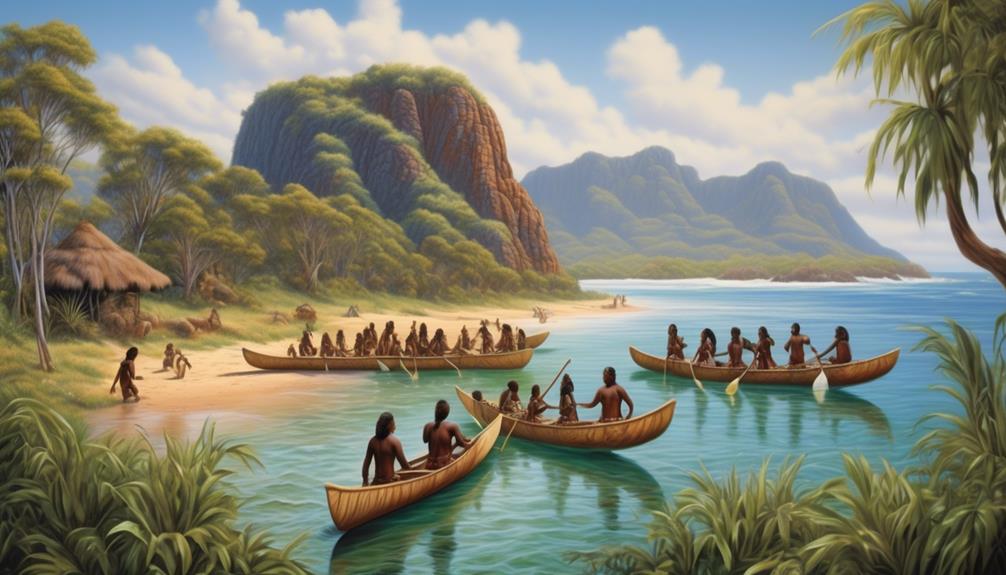
Having arrived in Australia over 65,000 years ago, the Aboriginal people established complex and diverse settlements across the continent, shaping their cultural identity and connection to the land.
The early exploration and settlement of Australia by the Aboriginal people were marked by a deep understanding of the environment, sophisticated social structures, and rich spiritual beliefs. This profound connection to the land influenced their settlement patterns and the development of intricate cultural practices.
- Sophisticated Settlement Patterns: The Aboriginal people exhibited diverse settlement patterns, including semi-permanent villages, seasonal camps, and rock shelters, reflecting their deep knowledge of the land and its resources.
- Adaptation to Varied Environments: Through early exploration and settlement, the Aboriginal people demonstrated remarkable adaptability to the diverse Australian environments, utilizing different techniques for hunting, gathering, and resource management.
- Social and Spiritual Significance: Settlements weren't only a means of survival but also held deep social and spiritual significance, serving as centers for cultural activities, ceremonies, and storytelling, reinforcing the interconnectedness of the Aboriginal people with the land.
- Cultural Diversity: The Aboriginal people's settlements showcased a rich diversity of cultural practices, languages, and traditions, reflecting their deep-rooted connection to specific regions and landscapes.
- Continuity and Change: The continuity of Aboriginal settlement over millennia highlights the enduring nature of indigenous culture, while also revealing the capacity for adaptation and innovation in response to environmental and social changes.
The early exploration and settlement of Australia by the Aboriginal people laid the foundation for their enduring connection to the land and the development of diverse and complex indigenous cultures.
Frequently Asked Questions
What Impact Did the Arrival of the Aboriginal People Have on the Environment of Australia?
The arrival of the Aboriginal people had a significant impact on the environment of Australia. Their deep connection to the land and understanding of ecological systems influenced their environmental stewardship.
Their traditional land management practices, such as controlled burning, shaped the biodiversity of the landscape. This approach fostered a balanced ecosystem, promoting the coexistence of various species.
The Aboriginal people's influence on biodiversity and environmental stewardship continues to be recognized and valued.
How Did the Aboriginal People Adapt to the Diverse Landscapes and Climates of Australia?
Adapting to Australia's diverse landscapes and climates, the Aboriginal people employed ingenious strategies. Their environmental impact was significant, as they utilized controlled burns for land management and created sophisticated water systems.
Despite the challenges, they thrived by harnessing their deep understanding of the land. This allowed them to develop unique cultural practices and traditions that sustained their communities for thousands of years.
What Role Did Oral Tradition and Storytelling Play in the Preservation of Aboriginal History and Culture?
Oral tradition and storytelling are integral to our cultural preservation. Through these community practices, we ensure the generational transmission of our history and values.
These narratives aren't just tales, but a living, breathing repository of our collective wisdom and experiences. They bind us to our ancestors and shape our identity.
Our oral traditions are the heartbeat of our culture, embodying the essence of who we're and where we come from.
How Did the Aboriginal People Interact With Other Indigenous Groups in Australia Upon Their Arrival?
In interacting with other indigenous groups, the Aboriginal people engaged in significant cultural exchange and integration. They traded goods and shared knowledge with neighboring tribes, leading to the enrichment of both societies.
This interaction fostered the development of diverse traditions and languages, strengthening the interconnectedness of indigenous communities across Australia. These exchanges were critical for the survival and thriving of Aboriginal culture, demonstrating the importance of cross-cultural interactions in shaping their history.
What Are Some of the Key Cultural Practices and Traditions That Have Been Passed Down Through Generations Within the Aboriginal Community?
Cultural practices and traditions within the Aboriginal community are deeply rooted in generational preservation. Oral storytelling is a vital aspect, ensuring the passing down of customs and knowledge.
Interactions with other indigenous groups have influenced and enriched these practices. The significance of these traditions lies in their continuity, providing a sense of identity and connection to the land.
These practices serve as a living testament to the resilience and cultural richness of the Aboriginal community.
Conclusion
In conclusion, it's clear that the Aboriginal people came to Australia through a combination of early human migration theories, including the land bridge hypothesis, genetic evidence, coastal migration, and island hopping.
Their cultural connections with Southeast Asia and archaeological discoveries also support their arrival and settlement in Australia.
It's fascinating to think about how these ancient peoples made their way to the continent, laying the foundation for the rich and diverse Aboriginal cultures we see today.
Mary is a passionate writer who brings creativity and a fresh perspective to our team. Her words have the power to captivate and inspire, making her an essential contributor to our content. Mary’s commitment to storytelling and dedication to promoting Indigenous culture ensures that her work touches the hearts of our readers. We’re fortunate to have her as part of our team.
